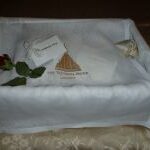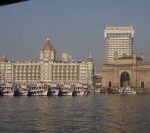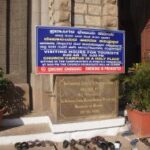
I’m sitting in Mumbai (Bombay), about 500 miles north of Bangalore in a hotel that you may have heard of—the 1903 Taj Mahal, which was the subject of a terrorist attack in 2008 that made the news  around the world. The legacy of that attack was a complete renovation of the hotel. When I was here in 1997 (around the same time of year), I remember the crowds as affluent (we were the only non-sheik or drug dealers, I commented at the time), and the rooms in the heritage wing as “dated” and spare at best.
around the world. The legacy of that attack was a complete renovation of the hotel. When I was here in 1997 (around the same time of year), I remember the crowds as affluent (we were the only non-sheik or drug dealers, I commented at the time), and the rooms in the heritage wing as “dated” and spare at best.
Florida International’s CIBER trip at the time was the first group that was admitted to the reopened hotel, so the Taj welcomed us with peach lemonade in the “club lounge,” and garlands, and with the news that we had been upgraded to the heritage wing (there’s a rather spare new wing built in the 1970s). I think I could get used to being upgraded, especially into the luxurious part of the hotel; it is world class, as I realized when Preejesh escorted me from the elevator, gave me his card (as the team leader for palace services). I’m reading “The India Way,” which I picked up at the airport—it’s a new Harvard Press book which distills the interviews four Wharton professors had with the heads of major Indian firms to postulate an “India way” for Multinational Corporations to conduct business. I think my students will be reading excerpts.
One of the companies, and one you have to discuss as a global powerhouse, is the Tata Group; the Tata group five years ago unveiled the Tata Nano, a real “Volkswagen” (people’s car) with a base price of under $2,000. It also owns the Taj hotel chain, Jaguar and Landrover, steel companies, etc.
I should note that the service at the hotel in Bangalore, also a Taj chain member, was also immaculate. Both hotels, however, have tighter security than most hotels. My cab in Bangalore, when permitted into the parking lot, had to have the trunk and the underbody examined. I guess it’s a measure of India’s neighbors….
Bombay is the commercial capital of India, with headquarters for most Indian companies (and Multinationals doing business here). It’s on the ocean (the Arabian Sea) and I remember reading early Clancy novels involving the Indian Navy headquartered here. It’s about 20 million population, but the traffic, while heavy, flows here. We’re getting a tour tomorrow, so maybe I will have a report then.
It’s far different than Bangalore, where we toured earlier today. Bangalore is a city of almost 9 million people, but less than a decade ago, it had 2 million people. That may explain the congestion and the state of the infrastructure. Interestingly, the city seems to be building monorails, rather than expressways, which has torn up the streets, but may be a more sensible first step toward controlling pollution.
 Among the sites was a garden, which was a cross section of Bangalore’s history. The founder of the city created the first part of the garden in 1537, along with a tower that marked the first boundary of the city. Tipu Sultan, whose history I discussed in my blog post on Mysore, expanded it. But it was the British who turned a 40-acre garden into a 240-acre one, and built a replica of the Crystal Palace, where there will be a flower
Among the sites was a garden, which was a cross section of Bangalore’s history. The founder of the city created the first part of the garden in 1537, along with a tower that marked the first boundary of the city. Tipu Sultan, whose history I discussed in my blog post on Mysore, expanded it. But it was the British who turned a 40-acre garden into a 240-acre one, and built a replica of the Crystal Palace, where there will be a flower  show in a few weeks to celebrate one of the major national holidays. The British, I should point out, recreated a lot of England in their far-flung empire, and it’s relatively easy to spot the old British military establishments in Bangalore. They now house the Indian military establishment. The colonial churches are also still in use, many of them in pastel colors. One of the names for Bangalore is “retirement city” because it had and has a relatively benign climate for India, without the extreme heat of Delhi or the cold of the foothills of the Himalayas. It seems to have been an important center for the British for
show in a few weeks to celebrate one of the major national holidays. The British, I should point out, recreated a lot of England in their far-flung empire, and it’s relatively easy to spot the old British military establishments in Bangalore. They now house the Indian military establishment. The colonial churches are also still in use, many of them in pastel colors. One of the names for Bangalore is “retirement city” because it had and has a relatively benign climate for India, without the extreme heat of Delhi or the cold of the foothills of the Himalayas. It seems to have been an important center for the British for that reason.
that reason.
The founder of the city started a Nandi temple—around the statue of the bull, which I believe is the carrier of Lord Shiva. The huge bull, carved from a single block of granite, was one of our stops on the city tour as well.
Talk to you tomorrow.
Namaste.